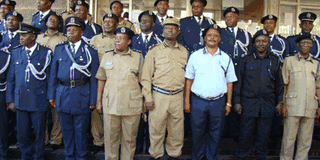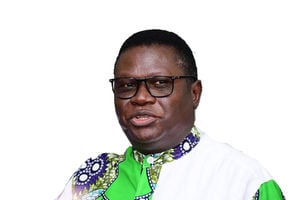Prime
Understanding Police ranks

Police officers of varying ranks pose for a group photo after a recent event at which they were decorated. Photo by Andrew Bagala.
What you need to know:
Length of service may contribute to one’s rank in the police force but there are other factors that determine one’s place in the structure.
When Assistant Inspector of Police John Michael Ariong died after sustaining serious injuries on the head, the biggest debate was not only on the cause of his death but also whether he was a senior or junior officer.
Given the fact that he had served for more than 26 years in the force, some people argued that that was enough to bestow on him “seniority”.
Some wondered how an officer with 26 years of policing experience could be at the rank of an Inspector while those who have recently joined the force have quickly graduated to Superintendents or Commissioners.
The debate of who is who in the police ranks, promotions and postings, has widely spread among senior officers.
However, Police spokesman Commissioner Asuman Mugenyi says ranks are given to officers basing on the police structure.
“The lowest rank in the force is Special Police Constable and the highest is the Inspector General of Police. The police structure stipulates what every officer does basing on the rank,” Mugenyi said.
The force also classifies those ranks into four other categories. In the first category, there are senior officers, who are at or above the rank of an Assistant Superintendent. They are also known as gazetted officers.
The next category is of the Inspectorate which covers Inspectors and Assistant Inspectors.
Sergeant and Corporals are tied in the third group and are referred to as Non-Commissioned Officers. The rest are in the fourth category and they are the Constables and Special Police Constables, who are regarded as “officers of other ranks”.
The higher the rank the bigger the salary
At the top of the police structure is the Inspector General, who is the chief executive and the chief in command. He or she is assisted by the Deputy Inspector General (DIGP), according to Article 213 of the Constitution of the Republic of Uganda.
It is this Article of the Constitution that the Inspector General of Police, Lt. Gen. Kale Kayihura, invokes whenever people question why he is always at scenes of crime other than delegating to his subordinates.
“I am here because my primary duty as the Inspector General of Police is to inspect. So I am here to do my constitutional obligations,” he often says.
Below the IG is the DIG whom many people believe gets most of his assignments from the IG which is not wholesomely the case.
A 2009 police structure report of the Public Service indicates that the DIG handles the Inspectorate department and Finance and Office Support Services.
Special units
These two departments carry out monitoring and evaluation, general and special inspection. In other words, he is in charge of the finances of the police and the procurement committee.
Officers of the IG and DIG ranks wield enormous powers above any other officers in the force that became difficult to remove them unless they have committed a crime or reached the retirement age.
The former DIG, Julius Odwee, says after the Justice Julia Ssebutinde Commission of Inquiry assessed the challenges of police chiefs overstaying, they recommended that the two top officers should serve on three-year term contract and only renewed after good performance.
“Even when the salary was recently increased by 235 per cent from Shs1.78m, I couldn’t breach the principles of purpose in committing myself to the required integrity of implementing the goals of Sebutinde Commission,” Mr Odwee said after retiring.
The same term contract principle applies to officers at the rank of Assistant Inspector General (AIG) and Senior Commissioner.
Officers at the rank of AIG come third in the police hierarchy and are meant to head directorates, and deputised by Senior Commissioners.
But because there are only 12 directorates against 13 officers at the rank of AIG, Gen. Kayihura has established special units that report directly to him where he has posted most of the undeployed officers.
These units Gen. Kayihura established have created room for most of the undeployed AIGs.
A police source said clashes have been noticed between the Operations and Kampala Metropolitan Police directorates that have similar roles and officers at the same rank.
Both Directorates are headed by AIGs and basically deal with operational issues so there is often a clash on who should do what.
However, some directorates are headed by officers below the rank of AIG, in acting capacity, as is the case with the Political Commissariat and Counter Terrorism directorates.
Commissioners Asuman Mugenyi and John Ndugutse are acting directors while a civilian, Mr Amos Ngabirano, heads the Information and Communication Technology Directorate.
Commissioner Mugenyi says although a directorate is supposed to be headed by an officer at the rank of AIG, the policy discouraged attaching ranks to an office.
“Ranks don’t define offices. A directorate is supposed to be headed by an AIG but any senior officer can head it in acting capacity,” Commissioner Mugenyi said.
The policy of tagging ranks to positions is more prominent among top senior officers in positions of directorates than departments.
Positions and offices
Officers operating at the department level are the professionals in those areas.
The Restructuring Review for the Uganda Police Force of 2009 recommended that the police management should desist from attaching ranks to jobs.
“Police still deploy staff in general terms based on ranks in specialised and professional departments. Examples of such areas are planning, human resource management and estates management,” the report observed.
“This practice in a way compromises the effectiveness and efficiency of service delivery offered by the institution to the citizens of Uganda,” the report says in part.
Although police departments are supposed to be headed by officers at the rank of a Commissioner, many are headed by officers at lower ranks but in acting capacity.
The beneficiaries of these recommendations are scientists and lawyers. Before the review, Dr Moses Byaruhanga and Dr Martin Mugume, who are at the rank of ASP, would not have been the heads of the Police Medical Services and the Police Canine Unit respectively.
Below the Commissioner is an officer at the rank of Assistant Commissioner (ACP) who often is the deputy in a department. In some instances, ACPs are heads of specialised units like the Air Wing Unit, Railway Unit and Oil Protection Unit.
Officers below ACP are of the rank of Senior Superintendent. In the police structure, Regional Police Commanders are supposed to be officers at the rank of SSP.
Officers at the rank of SSP are followed by Superintendents and also followed by Assistant Superintendents, who are last officers in the category of senior officers.
These officers at the rank SP and ASP are middle managers and act as District Police Commanders, officers in charge of Stations and investigations.
Ranks not only come with seniority but also some kind of immunities.
All officers below the rank of ASP are junior or subordinate officers recruited, promoted and disciplined by the Police Council.
The highest ranks of junior officers are inspectors or assistant inspectors.
“We group them under inspectorate. They are supposed to be in charge of police posts, traffic at the district level,” Mr Mugenyi said.
Execution of duties
The Police Act empowers an Inspector to manage a police unit, disperse an assembly, and order the taking of photographs of some suspects in custody.
However, there are some duties that are off-limit to an Inspector like driving a police car.
“When a police driver is promoted that rank, he or she has to leave driving and concentration on managing fleets,” an officer in the police human resource department said.
Inspectors are assisted by sergeants and Corporals in leading Constables and Special Constables in executing their programmes in the field.
Ranks
- Inspector General
- Deputy Inspector General
- Assistant Inspector General
- Senior Commissioner
- Commissioner
- Senior Superintendent
- Superintendent
- Assistant Superintendent
- Cadet Assistant Superintendent
- Inspector
- Assistant Inspector
- Head Constable Major (Scraped)
- Station Sergeant Constable (Scraped)
- Sergeant
- Corporal
- Constable
- Recruited Constable
- Special Constable
[email protected]




